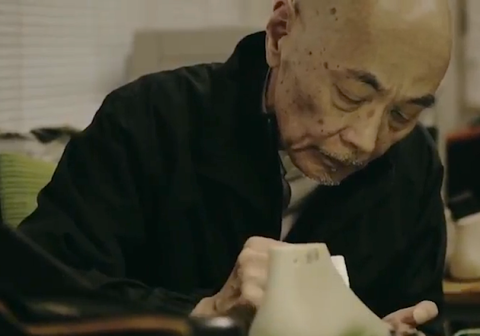Andy Warhol’s NYC Townhouse For Sale
April 23, 2013 § Leave a comment
Andy Warhol’s former 3,072-square-foot townhouse, located on Lexington Ave in New York, has just gone on the market for $5.795 million USD (approx. £3.75 million). The artist originally bought the house for $60,000 USD back in 1959 and lived there for 15 years, sharing the Carnegie Hill-area home with his mother. During this period the iconic pop artist created some of his most famous work, including the colorful renditions of Campbell’s soup cans, dollar bills and comic strips. The main floor was used as his painting studio, while upstairs there are four bedrooms (each with wood-burning fireplaces) and 4.5 bathrooms. Since Warhol lived there the home has passed through two different owners and has undergone a small restoration which included new interior finishes, updated fixtures and the addition of a garden-level kitchen.
Source : huhmagazine.co.uk
ADIDAS PRESENTS: ADIVISIONARIES – MR. OMORI
April 19, 2013 § Leave a comment
Adi Dassler’s vision was to provide every athlete with the best footwear for his or her respective discipline to help him or her get better, faster and stronger.
This principle guided Dassler through his career until his death in 1978. Since then the baton has been passed on to craftsmen, athletes and masters, who have shaped the adidas brand under Dassler’s original principles for the past three decades. In a series of films, adidas focuses on these ‘visionaries’ who have fashioned the path of the brand into what we know it as today. With the popularity in technical running footwear ever increasing, adidas delves into a day in the life of Mr.Omori for the first of the films in the series.
The master craftsman began working for adidas in 1999 bringing his techniques of hand cutting shoe patterns which helped create innovative shoes such as the adizero family. Mr.Omori’s dedication to his work attracted attention from all over the world, helping create shoes for legendary athletes for over 50 years. This intimate glimpse into his life documents his unique approach to his work and how in today’s mass production world, traditional hand crafted techniques still have an integral place.

The Polo Shirt History
January 27, 2013 § 1 Comment
The Birth
In the 19th and early 20th centuries, tennis players ordinarily wore long-sleeved white button-up shirts – worn with the sleeves been rolled up – flannel trousers, and ties. In the 1920s, René Lacoste – seven-time Grand Slam tennis champion – decided to design a more comfortable white, short-sleeved, loosely-knit piqué cotton shirt with collar, buttoned placket, and tennis tail – where the shirt is longer in the back to prevent it from pulling out of the wearer’s trousers or shorts. He first wore it at the 1926 U.S. Open championship. Later in 1927, Lacoste placed a crocodile emblem on the left chest of his shirt, as the American press had started to call him “The Crocodile” – a nickname he embraced from his fans because of his tenacity on the court.
René Lacoste
In 1933, after retiring from professional tennis, Lacoste founded a company named La Société Chemise Lacoste with André Gillier to produce the tennis shirts with a crocodile logo embroidered on the left chest which he often wore during his playing time and selling them in Europe and North America market.
Fred Perry
In the late 1940s, another tennis champion, Fred Perry – winner of eight Grand Slam tennis championships and the first player to win all four Grand Slam singles titles – was approached by Tibby Wegner to produce white knitted cotton pique shirt with short sleeves and buttoned placket similar to Lacoste tennis shirts. Launched in Wimbledon in 1952, the Fred Perry tennis shirt hit immediate success. The brand’s logo is a laurel wreath which is based on the original symbol of Wimbledon.
Reincarnation to Polo Shirt
In 1920, Lewis Lacey – a polo player – began producing a shirt embroidered with a logo of a polo player which was invented at the Hurlingham Polo Club, Argentina.
Formerly polo players wore thick long-sleeve shirts made of Oxford-cloth cotton with buttoned-down collar to keep the collars from flapping in the wind. When polo players became aware of Lacoste tennis shirt, they started to use it to play polo. Yet, Lacoste shirt was still called tennis shirt.
Polo Ralph Lauren advertisement
Until in 1967, Ralph Lauren opened a men’s tie store where he sold his own design ties under the label “Polo”. He later received the rights to use the trademark from Brooks Brothers – a clothier chain where he was employed as a salesman before. In 1970, he released a line of women’s suits which were tailored in a classic men’s style. That was the first time Polo emblem – depicting a polo player riding a pony – was seen, which was placed on the cuff of the women’s suit. Later in 1972, he included his tennis shirt as a prominent part of his Polo label. Due to the immense popularity of his label, the term polo shirt later became a universal moniker for the tennis shirt.
Later Uses
Over the latter half of the 20th century, as standard clothing in golf became more casual, many golf courses and country clubs require players to wear polo shirts as a part of their dress code. Moreover, producing polo shirt in various golf cuts resulted in specific designs of the polo shirt for golf. Polo shirt has also been widely used and becomes a standard category for almost every major clothier and available for both men and women. Notably, polo shirts are popularly worn in any circumstance where tees are not acceptable but formal attires are not required.
The T-shirt History
August 31, 2012 § Leave a comment
T-shirt began its life as a functional item of underwear used in the 19th century by cutting one-piece underwear into separate top and bottom garments and designed not to be seen. In the early days, it would have been considered offensive to reveal the cloth. Later on it was coined the name T-shirt due to the shape of the garment’s outline.
The beginning of the T-shirt stem from Europe where U.S. soldiers were sweating in their woollen uniforms while their European counterparts were less restricted in their lightweight cotton undershirts during the First World War. The U.S. Navy then issued crew-necked, short-sleeved, white cotton undershirts. It became very common for sailors and marines to wear these comfortable lightweight cotton undershirts under their uniforms. By the 1920s the T-shirt had become an official term in the American-English dictionary. And by the late 1930s some U.S. retailers were marketing them, namely Fruit of the Loom, Hanes and Sears, and Roebuck & Co.
The cotton T-shirt was standard issue as an undergarment in the U.S. armed forces during the Second World War. Later it became quite common to see returning U.S. servicemen wearing their uniform trousers with their T-shirts as casual clothing. The war also provided another preview of the T-shirt as soldiers crudely customized their vest-style tees to identify their station and using any materials they could find – often handmade, cut-out stencils, and vehicle spray paint.
In the 1940s and 1950s, colleges in U.S. started printing their names and logos on T-shirts, normally using flock iron-on fonts in the early days. These were sold in the college stores on campus for students to wear with American pride. Later versions of these U.S. university tees, such as Yale and Harvard, became a part of the early 1960s Brit mod look alongside other U.S. Ivy League-style preppy garments.
The trend for small U.S. businesses, such as garages, diners and electrical stores, to print their own logo or products on T-shirts for customers became common in the 1950s. They advertised brand loyalty in this way long before the major big league companies caught on. By the mid 1960s, these walking billboard advertising tees were big business.
Hollywood definitely had a big impact on the T-shirt. In 1951, Marlon Brando donned a thin, white T-shirt in “A Streetcar Named Desire”. Teens across the country went wild for the look and by the year ended, T-shirt sale reached US$ 180 million in total. Four years later, James Dean shocked the world by wearing his underwear outside on the big screen in “Rebel without a Cause”. This marked the T-shirt’s long-awaited progression from underwear to outerwear, infusing the style with the fashionable sex appeal at the same time. The rebel association was the catalyst for the style becoming a desirable item of clothing with the youth of the day and coincided with the birth of rock and roll.
The popularity of the printed rock and roll band tee exploded in the 1970s, but the roots lie firmly in the 1960s. Although mid 1960s invasion-style groups dipped their toes in the T-shirt market, it was West Coast gig promoters – such as Bill Graham pushing local acts like the Grateful Dead – who first realized this emerging potential to sell T-shirts as well as gig tickets at venues. The music industry capitalized the T-shirt when rock bands began selling T-shirts with their slogans and images at concerts. Later on, tie dye shirts became the entire craze especially in 1969 when advertiser Don Price produced hundreds of shirts and gave them away at Woodstock.
Later in the 1970s, the first wave of Sex Pistols and Clash fans – particularly those outside central London – had to create their own customized Kings Road-esque creations. These do-it-yourself tees were crudely vandalized and defaced using marker, tape, pins, and zips. The late 1970s then marked the birth of the “I ♥ NY” tee which are still popular today.
During the 20th century, the T-shirt went from military-issue wear to an iconic fashion statement. The shirt went through several mid-century phases, as a symbol of heroism worn by Second World War fighters, the rebel uniform of movie icons, the socially conscious garb of the 1960s peace movement, and the in-your-face costume of the punk rock scene. The T-shirt was also a democratizing force in the military because it was worn by all ranks, a philosophy extended to the civilian world when veterans by the likes of Elvis Presley, John F. Kennedy as well as the working man kept wearing the shirts after completing their service. And today, the influence of T-shirts reach every country across the planet and can be used for anything – from casual clothing to advertising, from souvenirs to protesting.
“In a word, the T-shirt is to clothing what the blank sheet of paper is to writing — a surface for imagination and free expression to run wild.” Charlotte Brunel
















